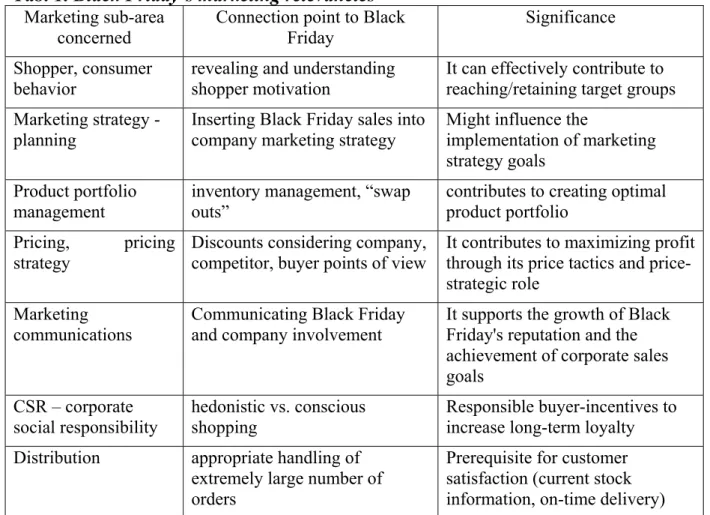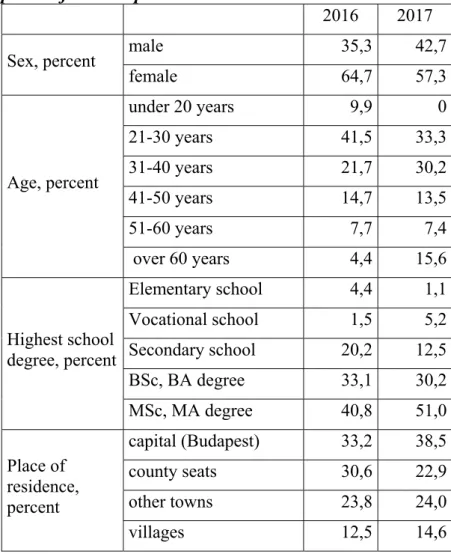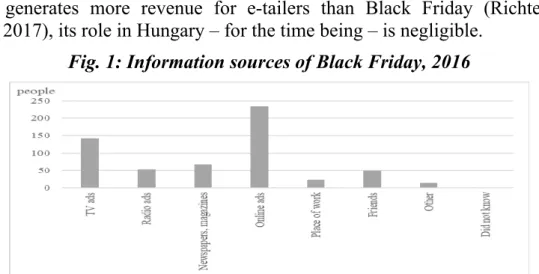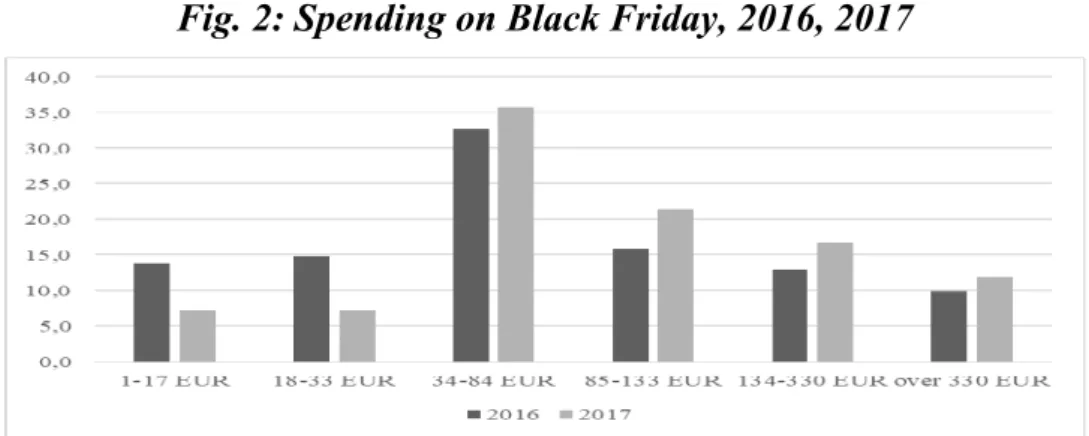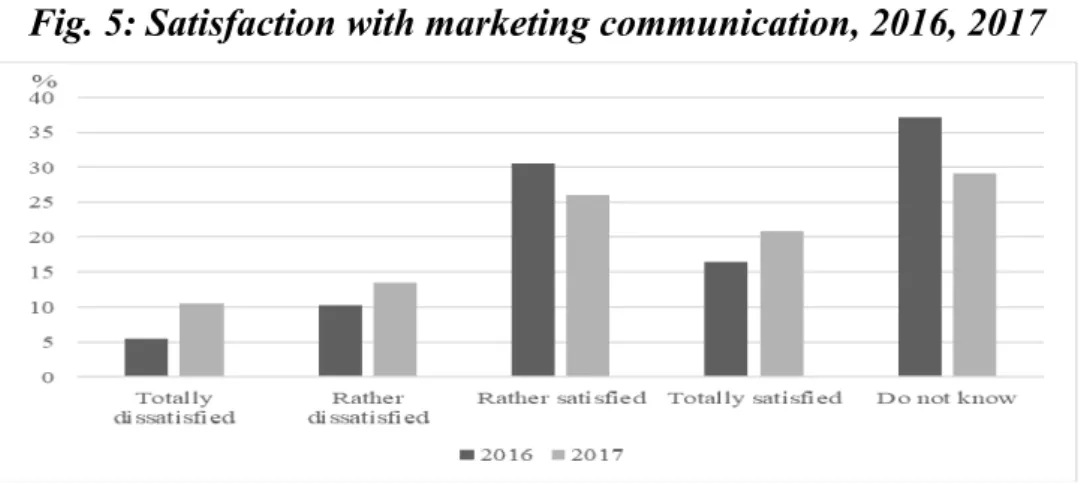BLACK FRIDAY SHOPPING IN HUNGARY
Kovács András, Sikos T. Tamás
Abstract: The central question of our study is to examine what features the Black Friday phenomenon has in Hungary, how it resembles to or differs from the international Black Friday trends. To answer this question we provide an overview of the main ideas on the topic discussed in international literature. Then with the help of answers of a questionnaire research from 2016 and one from 2017 we will highlight the most important similarities and differences. As we will see, in Hungary the buyers’
intent to participate is similar to other countries, but retailer behavior shows considerable differences compared to international examples. Descriptive methods, cross-tabulation, cluster analysis applied in our research.
Keywords: Black Friday, Retail, Customer Behavior JEL Classification: M31
Introduction
By now, Black Friday has not only become the day of biggest turnover for retailers in the United States, but it is also the real start to the "Christmas shopping fever", a serious social event, a hedonistic feast of consumption for the U.S. consumer society as Bell and her colleagues point out (Bell et al., 2014).
Since due to its importance and size Black Friday is now far from having simply business or marketing significance, it also raises serious social, psychological, decision-making and security issues. In the international (mainly US and UK) literature, math-based decision theory study (Wu, Zitikis, 2017) and an analysis of security issues related to Black Friday can also be found (Smith, Raymen, 2015).
Obviously, most researches related to Black Friday focus mainly on the aspects of consumer behavior. Consumer/shopper behavior researches primarily focus on the question of purchase/non-purchase and purchasing motivations (Kwon, Brinthaupt, 2015) (Delcea, Ioanas, Paun, 2017), examine the relationship between Black Friday and its dynamically growing online counterpart, Cyber Monday (Swilley, Goldsmith 2013), and reveal the buyers’ shop-preferences and shopping behavior (Simpson et al., 2011). In addition to customer and shopper behavioral researches, commercial logistic studies (McLeod et al., 2016) and social responsibility analyzes (Lennon et al., 2014) can be found in international literature.
We approach the well-known “Black Friday phenomenon” from a marketing point- of-view. After providing an international literature overview, we will highlight the special features and characteristics of Black Friday in Hungary. Relying on the results of online questionnaires, shopping behaviour (product and shop preferences, prices) and shopper-groups will be set up and described.
Our aim is to contribute to a better understanding of this important retail and marketing phenomenon by unveiling shopper behaviour, and describing and grouping different customers.
1 Statement of a problem
Hereinafter, we attempt to summarize all the relevant aspects of Black Friday, as it would be a rough simplification to examine Black Friday sales from a single specific marketing sub-perspective (Törőcsik, 2017) (Rekettye, 2003) (e.g. pricing, shopping behavior, or marketing communication aspect) (Tab. 1).
Tab. 1. Black Friday’s marketing relevancies Marketing sub-area
concerned Connection point to Black
Friday Significance
Shopper, consumer behavior
revealing and understanding shopper motivation
It can effectively contribute to reaching/retaining target groups Marketing strategy -
planning
Inserting Black Friday sales into company marketing strategy
Might influence the
implementation of marketing strategy goals
Product portfolio
management inventory management, “swap
outs” contributes to creating optimal
product portfolio Pricing, pricing
strategy
Discounts considering company, competitor, buyer points of view
It contributes to maximizing profit through its price tactics and price- strategic role
Marketing communications
Communicating Black Friday and company involvement
It supports the growth of Black Friday's reputation and the achievement of corporate sales goals
CSR – corporate social responsibility
hedonistic vs. conscious shopping
Responsible buyer-incentives to increase long-term loyalty Distribution appropriate handling of
extremely large number of orders
Prerequisite for customer satisfaction (current stock information, on-time delivery)
Source: own edition
The most important lessons learned from Tab. 1 are that Black Friday sales (in optimal cases) are not just a communication campaign with intensive price promotions aimed at boosting short-term pre-Christmas turnover, but are also affecting the marketing strategies and activities of the company for long-term business success in a rather complex way (Józsa, 2014). In order for the Black Friday sales to achieve the desired favorable effect, it is very important to consider logistical, CSR, product management and strategic aspects besides communication and pricing tasks.
Our above review highlights that even a sales-promotion activity may have many additional marketing implications, so it is particularly important to explore and analyze these connecting points.
2 Methods
Since previous research in Hungary did not deal with the "Black Friday phenomenon", we consider it important to reveal the most important features of consumer and shopper behavior related to it.
In the next part of our study we analyze the results of the questionnaire research (carried out between November 25-27, 2016 and November 24-27, 2017) on the Black Friday phenomenon, with the aim of exploring the most important features of the Hungarian consumer behavior.
As outlined in Tab. 1, we have already highlighted that several marketing dimensions of the Black Friday phenomenon could be investigated. Naturally, all aspects of Black Friday cannot be investigated within a framework of a single research because the different marketing areas, the company (supply) and the buyer (demand) side can only be explored with different methodologies and tools.
In our research, from the areas enumerated in Tab. 1 we focus only on the most important features of shopper behavior related to Black Friday in Hungary, and we do not deal with other marketing areas, such as Black Friday's marketing strategy and its specific sub-areas.
Our aim is to reveal awareness connected to Black Friday, purchase/non-purchase relations and the key determinants of purchases, including spending, shop and product preferences, as well as opinions related to Black Friday.
We have chosen the online questionnaire method for the research, although several other methods are available today, as pointed out by Kemény, Simon 2015. The questionnaire seemed to be the most suitable method for conducting the research for two reasons: on the one hand, as Babbie points out, this method is capable of executing a large number of direct observations (Babbie, 2008). On the other hand, the aim of our research is to describe and analyze the opinions and behavioral characteristics of consumers on Black Friday, and to this the questionnaire method provides a good basis (Ghauri, Grønhaug, 2011). The questionnaire method was supported by the fact that in the international literature a similar approach was used to explore the Black Friday shopping habits (Tsiotsou, 2017). We preferred the method of online questionnaire (Google Forms) because this made it possible to reach a large number of potential respondents in a short time, since due to the nature of Black Friday (it takes place once a year), it is of utmost importance to reach customers and get the most accurate information. In the period 27-30 November 2016 a total of 272 respondents filled in our questionnaire and in November 2017 a total of 96 respondents provided answers. The results (after data cleansing and re-encoding) were analyzed using IBM SPSS Statistics 20 and Microsoft Excel 2017 with descriptive statistical methods. Descriptive statistical methods, cross-tabulation and cluster analysis (Ward-method) were applied.
In our research we aimed to answer the following research questions:
• What is the extent of awareness of Black Friday in international and in Hungarian dimension?
• How can Black Friday customers be characterized by the terms of spending, product and shop preference?
• What is Black Friday's satisfaction like among buyers and among non-buyers?
• How did the respondents' opinions change between 2016 and 2017, given the fact that the special features of the Hungarian Black Friday campaign have also changed considerably.
• What are the “Black Friday shopper groups” formed with statistical methods (cluster analysis)?
In the course of the research, single- and two-pole differential scales were used to ensure that online response is fast and smooth, whatever platform respondent (computer, tablet, smartphone) used. Hereinafter, after the presentation of the sample, we will deal with each research question in separate chapters.
In our research, from a methodological point of view, the biggest challenge was how to measure the awareness of the Black Friday phenomenon and the shoppers’
behavior in the relatively short duration (a few days) of the event. The advantage of online questionnaires is that they are very quickly "applicable" and a large number of potential respondents can be reached, but the problem is that the resulting sample is not representative. Generally, as it is in our case, among the respondents young urban residents with higher education, and above the average digital literacy are overrepresented. (Tab. 2).
Tab. 2: Descriptives of the samples 2016 and 2017
2016 2017
Sex, percent male 35,3 42,7
female 64,7 57,3
Age, percent
under 20 years 9,9 0
21-30 years 41,5 33,3
31-40 years 21,7 30,2
41-50 years 14,7 13,5
51-60 years 7,7 7,4
over 60 years 4,4 15,6
Highest school degree, percent
Elementary school 4,4 1,1
Vocational school 1,5 5,2
Secondary school 20,2 12,5
BSc, BA degree 33,1 30,2
MSc, MA degree 40,8 51,0
Place of residence, percent
capital (Budapest) 33,2 38,5
county seats 30,6 22,9
other towns 23,8 24,0
villages 12,5 14,6
Source: own research
The demographic structure of the two examined samples represents the social groups that are important target groups for the Black Friday campaign: urban, highly educated, groups, relevant for advertising.
Although our sample does not represent all layers and groups of the Hungarian society, we aimed to reach people living in different parts of Hungary. Altogether we surveyed our responders in 83 different settlements and in all districts of the capital, Budapest.
3 Problem solving
In connection with the Black Friday phenomenon, we first investigated what sources the respondents use to obtain information. As Fig. 1 shows, Hungarian customers primarily use online sources to get informed. One possible reason for this is that – opposed to the international trends – Cyber Monday, specialized in online shopping, is not wide-spread in Hungary, so online retailers and companies using multi-channel distribution systems all focus on Black Friday. While in the US, Cyber Monday generates more revenue for e-tailers than Black Friday (Richter, 2015) (McGee, 2017), its role in Hungary – for the time being – is negligible.
Fig. 1: Information sources of Black Friday, 2016
Source: own research
It is also a special Hungarian phenomenon that the "official" day of Black Friday is not considered "binding" for commercial companies. This phenomenon was particularly strengthened in 2017 when, in addition to the "official" Black Friday Day of November 24, several major domestic retailers announced an “alternative Black Friday" day, or even a week. (The trend can be observed in other countries (Telegraph Reporters, 2017), but it has become rather "extreme" in Hungary.)
In our research we asked the respondents about the dates of Black Friday sales for the four largest domestic retailers dealing in home appliances.
A smaller proportion (20-40 percent) of respondents were able to the Black Friday day (Tab. 3) of the particular retailer select from the predetermined list. The best result was achieved by eMAG online retailer, who held its own sales on the "official" Black Friday Day on the 24th of November.
Tab 3: Dates of Black Friday deals by the largest electronic retailers and their reputation among responders, 2017
Company Date(s) of Black Friday deals Ratio of right answers, percent
Media Markt 17th and 24th of November 19,8 Euronics
Between 20th-26th of
November 30,2
E-Digital 17th of November 18,8
eMAG 24th of November 44,8
Source: own data collection from the websites of the selected retailers
It is also a Hungarian phenomenon that the expression "Black Friday" is merely a synonym for a significant price discount, and has no strong historical, socio-cultural
background like it does in the USA (Bell et al., 2014). As a result, in 2017 and 2018,
"Winter Black Friday" and "Spring Black Friday" are advertised by major touristic and retail companies (Auchan, szallasvadasz.hu, etc.) If this trend continues, we are afraid, Black Friday will become only a synonym for a (significant?) price reduction in Hungary and will lose (or fail to get) the prestige value it has in the US and other Western European countries.
3.1 Product preferences, spending, distribution channels
According to our research, 37 percent of the respondents did some shopping on Black Friday in 2016. This rate rose to 44 percent in 2017, which is roughly equivalent to the rate of participation observed in countries of similar development. Tsiotsou also found a 1/3 turnout in Greece (Tsiotsou, 2017), but in developed countries this rate is much higher. In the US Kwon and Brinthaupt identified 63 percent customer involvement (Kwon, Brinthaupt, 2015), but the research conducted by Pricewaterhose Coopers in 2017 showed “only” 35 percent participation rate. At the same the significance of Cyber Monday increased considerably (PricewaterhouseCoopers, 2017).
The product preference of Black Friday buyers is in line with international trends.
Most of the surveyed respondents purchased technical items (50 percent) and clothing products (30 percent) during the period of sales. However, our research reveals that none of the retailers wants to miss out on Black Friday, so more food retailers, furniture shops, and book and toy stores have announced a Black Friday sale.
The amount spent and type of product purchased during the Black Friday campaign is well illustrated by spendings (Fig. 2). In Hungary willingness to spend is naturally limited by the amount of the available disposable income (Medgyesi, 2016), so spending per capita is far behind the values of the more developed countries. While the modal value of Hungarian spending allows for the purchase of a small household appliance, an IT accessory or a few fast-fashion garments (between EUR 30 and EUR 80), in the US the per capita Black Friday spending is 100-500 USD (Kwon, Brinthaupt, 2015).
Fig. 2: Spending on Black Friday, 2016, 2017
Source: own research
As mentioned earlier, the fact that Cyber Monday has not (yet) been established in Hungary has a significant role in the preference of retail outlet, so online retailers concentrate almost exclusively on Black Friday. This is due to the fact that the popularity of webstores is the greatest (Fig. 3), which is in line with international trends (Swilley, Goldsmith, 2013) (PricewaterhouseCoopers, 2017).
Fig. 3: Preferred shop types on Black Friday, 2016
Source: own research
3.2 Shopping satisfaction
In the last part of our research, we investigated customer satisfaction connected to Black Friday sales on a four-stage, two-pole differential scale where we offered the possibility to answer "I do not know" because we asked the question from all respondents, not only from those who actually did buy something. (We asked all respondents because we have also investigated factors (prices, marketing communication, etc.) which are not directly related to the purchase.).
In the following, we examined satisfaction with product selection, prices and advertising (marketing communication) based on the respondents' answers. Generally speaking, both in 2016 and 2017, 30-40 percent of the respondents (typically those who did not buy anything on Black Friday) were unable to judge prices, supply, and company communications. Among the respondents – those who expressed a firm opinion about prices and the supply of products – those who were satisfied and those who were not were almost in the same proportion (Fig. 4). From 2016 to 2017, the proportion of respondents who were satisfied somewhat reduced, which can be explained by the fact that retailers lured buyers with smaller (generally 20-40 percent) discounts, 60-70 percent reductions were low. The rate of price reduction is also a significant difference between the Hungarian and international Black Friday events.
Fig. 4: Satisfaction with prices, 2016, 2017
Source: own research
Satisfaction with product availability and price levels is considerably lower than satisfaction with marketing messages (Fig. 5). This indicates that most Black Friday retailers are investing significant resources in informing potential buyers about the range of discounted products and the extent of their sales.
Fig. 5: Satisfaction with marketing communication, 2016, 2017
Source: own research
3.3 Classification of shoppers and non-shoppers
After not finding space-based differences in shopping patterns, we tried to form groups from surveyed people, based on their opinions related to the Black Friday product supply, prices, communication, availability, services and delivery. These six categories (Tab. 4) were measured in 1-4, bipolar Likert scales with an additional “I cannot judge” (0) value. (value 1: totally dissatisfied; 2: rather dissatisfied; 3: rather satisfied; 4: totally satisfied)
In order to group the sample, we first used hierarchical clustering with Ward’s method. The test and its visualisation (dendrogram) indicated 6 different clusters, then we launched a K-mean clustering with 6 clusters. In Tab. 4 the final cluster center values can be seen which show the differences among the clusters. Using these values and cross-tabs with cluster membership and shopping activity we named each cluster, as Tab. 4 indicates. In Tab. 5 a crosstab of the shopping activity in each cluster (shopper/non-shopper numbers) can be found.
Tab. 4: Final cluster center data, 2016
Clusters
1 2 3 4 5 6
Satis- fied shop- pers
Advertis- ment sensitive
non- shoppers
Dissa- tisfied
shop- pers
Informed shoppers
who hardly
shop
Semi- satisfied shoppers and non- shoppers
Non- informed
people – non shopper
Satisfaction with prices 3,15 ,74 1,52 2,55 2,63 ,05
Satisfaction with
product supply 2,94 ,81 1,38 2,45 2,86 ,06
Satisfaction with advertisment and communication
2,89 2,90 1,24 3,27 3,34 ,04
Satisfaction with
product availability 2,86 ,29 1,76 1,77 2,26 ,02
Satisfaction with
servise level 3,39 ,23 1,19 ,00 2,31 ,02
Satisfaction with
delivery 3,39 ,00 1,29 ,14 1,06 ,01
Source: own research
Tab. 5: Crosstabs on shopping and cluster membership, 2016 Cluster Number of Case
1 2 3 4 5 6
Satis- fied shop- pers
Advert- isment sensitive
non- shoppers
Dissati sfied shoppe
rs
Informed shoppers who hardly
shop
Semi- satisfied shoppers and non- shoppers
Non- informed
people- non shoppers Count Count Count Count Count Count Have you shopped
on Black Friday week?
Yes 60 0 9 7 17 8
No 6 31 12 15 18 89
Number of Cases in each Cluster
272 66 31 21 22 35 97
Source: own research
The above mentioned groups of customers can be characterised as follows:
1. Satisfied shoppers
They are the most satisfied group in each measured dimension (Tab. 4). In this group most responders shopped during the Black Friday week (90 percent), and – according to the data in Tab. 4 – they were rather or totally satisfied as the average values show in Tab. 4. To this group belong 22 percent of all responders, and they supposed to be the “Black Friday fans in Hungary”.
2. Advertisement sensitive – non-shoppers
This group of customers was focused on Black Friday communication. They had information from different ad-sources, but none of them shopped during the Black Friday week (Tab. 5). The group average values are close to zero in case of prices, product availability, etc. (the responders could not judge them – because they did not shop), but they were rather satisfied with the marketing communication of the Black Friday, it means that the messages of companies reached them. We can conclude that in case of these shoppers the marketing communication was partly successful because retailers reached the awareness of customers, but they failed to convince them to shop.
3. Dissatisfied shoppers
In this group customers were rather or totally dissatisfied with the Black Friday event. The average values of all the measured dimensions are near 1 (Tab. 4). Maybe this is the reason why only 43 percent of this group shopped during the Black Friday week. Supposedly they originally planned to shop in the Black Friday week, but they were dissatisfied with the offer of retailers in general.
4. Informed shoppers who hardly shop
Only 32 percent of this group reported that he or she shopped during the Black Friday week. On average basis they were rather satisfied the product supply and prices (average values over 2), and they were almost totally satisfied with the advertisement activity of retailers (value over 3), but they could not judge the product availability, retail services and delivery. It means that they were reached by the retailers’ messages, they reviewed the market offer but eventually they did not shop. The main differences between the 3rd group (“Dissatisfied shoppers”) and this 4th group (“Informed
shoppers who hardly shop”) can be depicted by the judgement of product supply, prices and advertisement. While the 3rd group members were totally dissatisfied with them, the members of 4th group were generally satisfied with these dimensions.
Further researches are needed to unveil the reasons behind. The 4th group composes nearly 10 percent of the entire sample, it means their shopping behavior may be relevant and important enough for different retailers.
5. Semi-satisfied shoppers and non-shoppers
This group of surveyed people forms about 15 percent of the total sample. This group of responders are the “unconfirmed ones”. About 50-50 percent are the ratio of shoppers and non-shoppers in the group. They average satisfaction with the researched dimensions (prices, product availability, delivery, etc.) are between the “rather unsatisfied” and “rather satisfied” levels. Considering these data, we can conclude that there is still room to improve the retail companies’ marketing and retailing activities in order to extend the ratio of Black Friday shoppers.
6. Non-informed people – non shoppers
More than 36 percent of the sample reported that they had no information on Black Friday at all. The mass majority of this group (over 90 percent) has not shopped during the Black Friday week. Although the Black Friday event started in 2014 in Hungary, 1/3rd of the surveyed people was still totally uninformed after 3 years. These people mean the most important target group for retailers even nowadays if searching for new customers.
4 Discussion
In our paper the Hungarian Black Friday is described from a customer behavioural point-of-view. Because of the non-representative sampling method our findings may be not valid for the entire Hungarian society, although our results are in line with other international examples especially in those countries that have similar socio-economic conditions (e. g. Greece, Romania) (Tsiotsou, 2017) (Delcea, Ioanas, Paun, 2017). The shoppers-non-shoppers ratio shows similar values (1/3-2/3 of the shoppers), the frequencies also show similarities in international comparison, but spending values may vary depending on the economic development level of the selected country.
Further Black Friday researches are needed to unveil the shopping motivations and the behaviour of different retailers in Black Friday sales. Our findings may contribute to a more effective and efficient marketing activities of retail companies that are or will be engaged to Black Friday sales in Hungary and in third countries too.
Conclusions
During our research we highlighted some important features of shopper behavior observed during the 2016 and 2017 Hungarian Black Friday campaigns, in comparison with strong international trends.
Our main findings are as follows:
• In the Hungarian Black Friday sales more than 1/3 of the respondents participate as a buyer, and this trend is in line with international examples, especially in respect of countries where the per capita income is similar to the Hungarian income level.
• Hungarian spending significantly lags behind the international spending level, primarily smaller household appliances, fast fashion clothing and smaller IT devices are bought during the sales period.
• During the Hungarian Black Friday sales period online retailers are the most successful, presumably due to the demand side, because domestic buyers prefer shopping opportunities with practical, fast, and lower-priced products to shopping experience. On the supply side, it is crucial that Cyber Monday is missing from the Hungarian trade palette
• The decisive part of the respondents (about half of the strong opinion formers) is not satisfied with either the range of discounted products or with the available discounts. The reason for this might be that a wide range of customers in the online and offline media are aware of the product range and price discounts of the international Black Friday phenomenon, compared to which the discounts and the available product range is more modest. Thus, it is understandable that a large number of customers are dissatisfied with the characteristics of domestic supply
• There are no geography-based differences in the shopping behavior of the surveyed people, we could not identify statistically significant differences in several space-divisions.
• We defined six different groups with cluster analysis. There are solid differences among the groups referring to the advertisement sensitivity, the evaluation of product supply and price levels, and different retail services (availability, delivery)
We found that Hungarian Black Friday is in line with international trends with some special national characteristics. Among them the low level of spending, the online dominancy (lack of Cyber Monday) are the most important. Our customer grouping highlights the differences in shopping/non-shopping, satisfaction/dissatisfaction and information supply. These findings may be useful for international comparison in future Black Friday researches.
References
Babbie, E. (2008). A társadalomtudományi kutatás gyakorlata [The practice of social research]
Budapest: Balassi Kiadó.
Bell G. C., Weathers M. R., Hastings S. O., Peterson E. B. (2014). Investigating the Celebration of Black Friday as a Communication Ritual. Journal of Creative Communications, 9(3) pp. 235–251.
Delcea C., Ioanas E., Paun R. (2017). Are You Really Influencing Your Customers?: A Black Friday Analysis. In: BILGIN M H. et al (eds.) Empirical Studies on Economics of Innovation, Public Economics and Management, Springer, pp. 225-240
Ghauri P., Grønhaug K. (2011). Kutatásmódszertan az üzleti tanulmányokban, [Research methods in business studies] Budapest: Akadémiai Kiadó.
Józsa L. (2014). Marketingstratégia – A tervezés gyakorlata és elmélete [Marketing strategy – The application and theory of planning]. Budapest: Akadémiai Kiadó.
Kemény I., Simon J. (2015). Az online vásárláshoz köthető minőségészlelés alakulása egy konkrét hazai online könyvesbolt esetében [E-purchase quality perception in the case of a Hungarian online bookstore] Marketing & Menedzsment, 2015/1. pp. 30-42
Kwon H. J., Brinthaupt T. M (2015). The motives, characteristics and experiences of US Black Friday shoppers. Journal of Global Fashion Marketing, Vol. 6, No. 4, pp. 292–302
Lennon S. J., Lee J., Kim M., Johnson K. K. P. (2014). Antecedents of consumer misbehavior on Black Friday: A social responsibility view. Fashion Style and Popular Culture, Vol 1 Number 2.
McGee T. (2017). Millennial Habits on Black Friday 2015 vs. 2017. Target Marketing. Available at:
http://www.targetmarketingmag.com/post/millennial-habits-on-black-friday-2015-vs-2017/
[17.07.2019].
McLeod F., Cherrett T., Bailey G., Dickinson J. (2016). ‘SHOP AND WE’LL DROP’ ‐ Understanding the impacts of student e-shopping on deliveries to university halls of residence during Black Friday week. Conference Paper. https://www.researchgate.net/publication/312627294
Medgyesi M. (2016). A háztartások megtakarításai és eladósodottsága Magyarországon [Dept status and savings of Hungarian households], 2008-2015 In: Kolosi T., Tóth I. GY. (2016), Társadalmi Riport [Social Report] 2016. Budapest: TÁRKI.
PricewaterhouseCoopers (2017). Holiday Outlook.
https://www.pwc.com/us/en/consumermarkets/assets /pwc-consumer-markets-2017-holiday-report.pdf [03.04.2018]
Rekettye G. (2003). Az ár a marketingben [Price in marketing]. Budapest: KJK-Kerszöv.
Richer, F. (2015). The Billion-Dollar Holiday. Statista.com. Available at:
https://www.statista.com/chart/4063/thanksgiving-weekend-e-commerce-sales/ [17.07.20019].
Simpson L., Taylor L., O’Rourke K., Shaw K. (2011). An Analysis of Consumer Behavior on Black Friday. American International Journal of Contemporary Research, Vol. 1 No.1; July http://www.aijcrnet.com/journals/Vol._1_No.1_July_2011/1.pdf
Smith O., Raymen T. (2015). Shopping with violence: Black Friday sales in the British context.
Journal of Consumer Culture, 17(3) pp. 677-694.
Swilley, E., Goldsmith, R. E. (2013). Black Friday and Cyber Monday: Understanding consumer intentions on two major shopping days. Journal of Retailing and Consumer Services, 20(1), pp. 43-52 Telegraph Reporters (2017). Which shops aren't taking part in Black Friday 2017 and why?. The Telegraph. Available at: https://www.telegraph.co.uk/black-friday/0/shops-arent-taking-part-black- friday-2017/ [17.07.2019].
Törőcsik M. (2017). Fogyasztói magatartás - Insight, trendek, vásárlók. [Customer behavior –insight, trends, shoppers] Budapest: Akadémiai Kiadó.
Tsiotsou H. R. (2017). „Black Friday”: Attitudes Behavior and Intentions of Greek Consumers In:
Martínez-López F. J. et al (eds.) Advances in National Brand and Private Label Marketing. Springer.
pp. 11-17
Wu J.–Zitikis R. (2017). Should we opt for the Black Friday discounted price or wait until the Boxing Day?. The Mathematical Scientist 2017/1. https://arxiv.org/pdf/1612.05855.pdf
Contact Address
Dr. habil. Kovács András Ph.D.,
Budapest Business School, Faculty of Commerce, Catering and tourism Alkotmány street 9-11., H-1054 Budapest, Hungary
Email: kovacs.andras2@uni-bge.hu Phone number: +36705039796 Prof. Dr. Sikos T. Tamás, DSc.,
National University of Public Services, Faculty of Science of Public Governance and Administration, Institute of Public Management and Administration
Ludovika square 2., H-1083, Budapest, Hungary Email: sikos.t.tamas@uni-nke.hu
Phone number: +36309212273
Received: 11. 03. 2019, reviewed: 26. 06. 2019 Approved for publication: 30. 08. 2019
